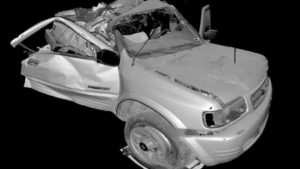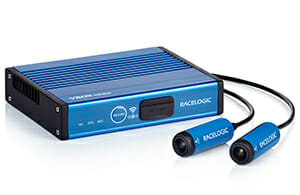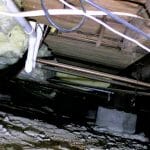Engineering Equipment
To find definitive answers backed by evidence, our experts rely on specialized engineering equipment. Whether it is an accident reconstruction, moisture intrusion evaluation, slip/trip and fall, or laboratory analysis, our engineers are equipped with tools that will assist them in finding the cause and origin of a failure.
Failure Analysis & Metallurgy Testing Techniques
- Scanning Electron Microscopy
- Energy Dispersive Spectroscopy
- Optical Fractography
- Hardness Testing
- Mechanical Testing
- Chemical Analysis
- XRD (X-ray powder diffraction)
3D Laser Scanner for Crash Scene and Complex Building Evaluations
 Our experts utilize a FARO 3D Laser Scanner for fast and exact indoor and outdoor measurements in three dimensions. The scanner produces photo realistic 3D images of real world objects or scenes. It captures several million 3D coordinates and creates a 3-dimensional impression of the surroundings.
Our experts utilize a FARO 3D Laser Scanner for fast and exact indoor and outdoor measurements in three dimensions. The scanner produces photo realistic 3D images of real world objects or scenes. It captures several million 3D coordinates and creates a 3-dimensional impression of the surroundings.
The tool can be used in cases involving accident reconstruction and structural analysis of complex buildings, or for scene preservation.
Recording Vehicle Speed & Distance Traveled
 In addition to crash data, our accident reconstructionists utilize specialized equipment for recording speed and distance traveled. The VBOX Video HD2 provides our experts with real-time synchronized video and data with graphical overlay. Although developed to assist race car drivers to improve speed and handling, the VBOX data is perfect for use in the accident reconstruction process.
In addition to crash data, our accident reconstructionists utilize specialized equipment for recording speed and distance traveled. The VBOX Video HD2 provides our experts with real-time synchronized video and data with graphical overlay. Although developed to assist race car drivers to improve speed and handling, the VBOX data is perfect for use in the accident reconstruction process.
It can identify the maximum speed of a vehicle in question, and it can be helpful in evaluating low-speed collisions. For more information, visit our Recording Vehicle Speed & Distance Traveled page.

Crawl Space & Steep Roof Robot
Hard to access spaces are no longer off limits with the X-Bot Inspection Robot. By using this innovative engineering equipment, our experts can access small dark crawl spaces, steep roofs, and structural compromised or hazardous locations by using the robot camera. Operated by our trained experts, this inspection robot will document spaces through hi-definition videos and photos.
- Robot on roof
- Control view
- Photo taken of calked nail hole
- Photo taken in dark crawl space
X-Ray Equipment
 U.S. Forensic’s laboratory is equipped with x-ray machines that can be used for non-destructive testing of failed components and tires. This equipment can also be used by our engineers and experts to identify hidden evidence in melted debris after a fire. For more information about our laboratory services, please visit our engineering lab page.
U.S. Forensic’s laboratory is equipped with x-ray machines that can be used for non-destructive testing of failed components and tires. This equipment can also be used by our engineers and experts to identify hidden evidence in melted debris after a fire. For more information about our laboratory services, please visit our engineering lab page.
Infrared Technology & EIFS Moisture Meters
 When warranted, U.S. Forensic can provide a non-destructive inspection to determine the source of moisture. An infrared camera is used to photograph walls, roofs, and other hidden areas within a structure with the purpose of identifying moisture, electrical, or temperature problems.
When warranted, U.S. Forensic can provide a non-destructive inspection to determine the source of moisture. An infrared camera is used to photograph walls, roofs, and other hidden areas within a structure with the purpose of identifying moisture, electrical, or temperature problems.
EIFS or “synthetic stucco” became widely used in the 1980s. It was first used in commercial construction and became popular in residential structures as well. The use of an EIFS moisture meter allows our engineers to easily identify the source of moisture and to locate areas in the building that have been affected by moisture. Most moisture intrusion occurs around the building openings, such as windows or doors, and around flashing. We can determine the source of the moisture and whether or not it is associated with a weather event or construction defect.
English XL VIT – Slip Resistance Testing
 We have Certified Tribometrists on staff that can operate the English XL VIT. These are articulated strut devices that are preferred over other types of tribometers because they measure wet slip resistance, are portable, and include a variety of features that simulate human ambulatory mechanics, including heel contact of the leading leg when walking. The biofidelity of the English XL VIT tribometer allows a forensic engineer certified in its proper use (“CXLT” certification) to obtain meaningful slip resistance values of walkway surfaces to help property owners ensure the safety of visitors and provide walkway surfaces with sufficient slip resistance to reduce the likelihood of slip and fall injuries. For more information, you may access the U.S. Forensic Article on Slip Resistance.
We have Certified Tribometrists on staff that can operate the English XL VIT. These are articulated strut devices that are preferred over other types of tribometers because they measure wet slip resistance, are portable, and include a variety of features that simulate human ambulatory mechanics, including heel contact of the leading leg when walking. The biofidelity of the English XL VIT tribometer allows a forensic engineer certified in its proper use (“CXLT” certification) to obtain meaningful slip resistance values of walkway surfaces to help property owners ensure the safety of visitors and provide walkway surfaces with sufficient slip resistance to reduce the likelihood of slip and fall injuries. For more information, you may access the U.S. Forensic Article on Slip Resistance.
HVE 2D and 3D Accident Reconstruction Software
Unlike animation, HVE software utilizes physics to simulate an accident. This technology allows our experts to simulate real-world crashes and identify potential sources of occupant injury. This is a great tool that illustrates to client and jurors what occurred in an accident.
In addition to the accident reconstruction software, our engineers use a total station to digitally map the accident site. It can also be used to map the damages to a structure. Fore more information, visit our Accident Reconstruction page or out Tire Expert website.
Electrical Testing Engineering Equipment
 A megohmmeter is used by our experts to measure the electrical resistance of insulators. This can be used to test electrical equipment and wiring after an electrical surge, lightning strike, or flood. To learn more, visit our HVAC Systems & Lightning or Electrical pages.
A megohmmeter is used by our experts to measure the electrical resistance of insulators. This can be used to test electrical equipment and wiring after an electrical surge, lightning strike, or flood. To learn more, visit our HVAC Systems & Lightning or Electrical pages.
Roof Scanners
Our engineers also utilize non-invasive roof scanners that are designed for precise and non-destructive evaluation of moisture conditions and leak tracing in roofing and wall systems of a structure.
Featured Experts for this Forensic Service
| Name | Title |
|---|---|
| Erick H. Schlender, P.E., CFEI, CVFI | Professional Engineer/Fire Investigator |







